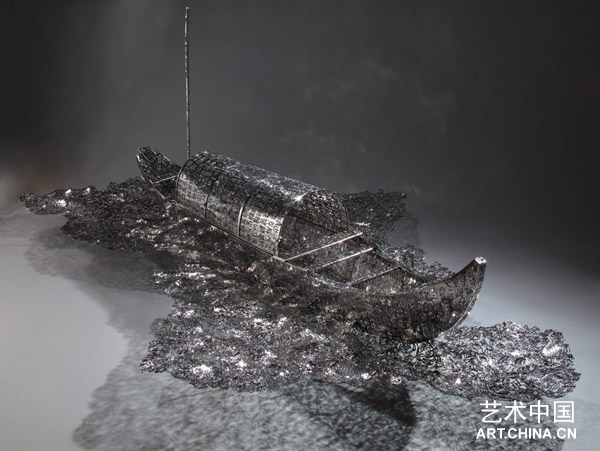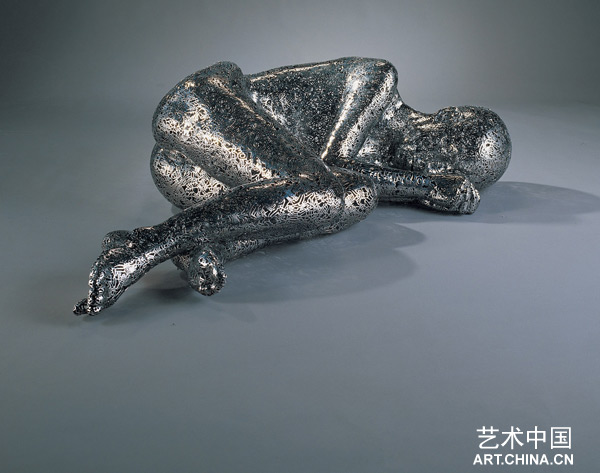
鄭路 慈航 257×170×100cm 不銹鋼 2009
展覽主題:讀空——鄭路雕塑個(gè)展
開幕時(shí)間:2009年9月12日 下午3:30
展覽時(shí)間:2009年9月12日—10月6日
展覽地點(diǎn):北京新時(shí)代畫廊
電話:+86-10-59789282
傳真:+86-10-59789285
E-mail:newage4355@yahoo.com.cn
一直致力於發(fā)現(xiàn)並推出當(dāng)代藝術(shù)新銳的北京新時(shí)代畫廊,將於2009年9月12日舉辦“讀空:鄭路雕塑個(gè)展”。此次展覽是鄭路的首次個(gè)展,將集中而全面呈現(xiàn)他的藝術(shù)創(chuàng)作。
本次展覽主題為“讀空”。“讀”即誦書念字,閱讀文章。他的雕塑作品,是由文字構(gòu)成的,並且,作品中的文字,成句成文,可以閱讀,産生文之意韻與作品主題思想相關(guān)聯(lián);“空”,一方面,著眼于作品本身的視覺特徵——鏤空形式,呈現(xiàn)出“去除”物質(zhì)實(shí)體,而只“存有”空殼的視覺直觀;另一方面,“空”,也是虛空、空靈之意,強(qiáng)調(diào)了作品追求內(nèi)在東方審美生命情調(diào)的意境。
本次展覽展示的7件作品,是由兩萬餘不銹鋼漢字焊接而成,組成作品的文字或詩或文 。在此,中國書法文字與雕塑意韻交相呼應(yīng),互相生成。漢字具有豐富的形態(tài)之優(yōu)美,中國文學(xué)文字能夠産生豐富的思想之意韻。以漢字構(gòu)成的雕塑作品,成為藝術(shù)家感悟思考現(xiàn)實(shí),進(jìn)行藝術(shù)表現(xiàn)的媒介。在此,既突出作品自身存在的一種文韻、意韻,又映射著一種 “虛”、 “空”、“陰”、“陽”。並且在光源的作用下,作品進(jìn)一步在“存與留”、“虛與實(shí)”中無窮變幻延伸開來。
鄭路自小對中國書法由來已久的情愫,對中國傳統(tǒng)繪畫講求詩、書、畫、印結(jié)合的內(nèi)涵體悟,以及受那些展現(xiàn)著中國古老文明光輝的青銅器之器物功能與其銘文相互輝映的啟發(fā),形成了他以中國漢字及其産生的相關(guān)意韻,來進(jìn)行雕塑藝術(shù)的創(chuàng)作。
文字,既作為鄭路雕塑作品的基本元素,又是承載資訊的媒介,鄭路藉以“文”與“字”去探求同自然呼應(yīng)的方式,讀進(jìn)文字的意境,進(jìn)入空的內(nèi)心。將文化載體的漢字,從平面變?yōu)榱Ⅲw,由會(huì)意賦予形象,誠所謂文以化成。通過豐富與拓展?jié)h字的審美空間,有形的“文”,用雕塑的語言“化”入人的靈魂。
Exhibition Listing on Sept of NEW AGE GALLERY
Theme: Interpretation of Emptiness--Zheng Lu’s Solo Exhibition of Sculpture
Opening: Sep 12, 2009, 3:30pm
Date: Sep 12, 2009—Oct 6, 2009
Venue: New Age Gallery, Beijing
8502#, D09 Area, 798 Zhong Er St., No.4 Jiu Xian Qiao Road, Chao Yang District, Beijing. PC: 100015
Tel: +86-10-59789282
Fax: +86-10-59789285
E-mail: newage4355@yahoo.com.cn
Beijing New Age Art Gallery, which has been committed to discovering and introducing to the public young contemporary artists, is pleased to present a solo exhibition on Sept. 12, 2009, under the title “Interpretation of Emptiness: Zheng Lu’s Solo Exhibition of Sculpture”. This exhibition, as Zheng Lu’s first solo, will give a broad overview of his artistic career.
In view of the title “Interpretation of Emptiness”, “interpretation” refers to “reading or reading aloud”. The sculptures are based on characters composed in lines or in passages for reading, so as to establish the connection between the artistic charm and the theme. “Emptiness”, on one hand, derived from the pierced works’ visual feature, indicates the visual dissociation from the physical reality and the “existence” of hollow frame; on the other hand, “emptiness”, carrying the meaning of “nonbeing” and “etherealness”, stresses the pursuit of intrinsic beauty of life particular to the East.
The seven works to be exhibited are composed of more than 20,000 welded stainless steel Chinese characters that make up the texts or poems of the works at the same time. Here, Chinese calligraphy and the sculptures are complementary and interdependent. The Chinese calligraphy is known for its formal beauty, while the characters in Chinese literature are capable of generating rich connotation. A sculpture composed of characters naturally becomes a medium for life experience and artistic expression. Therefore, the appeal of words and their connotation are highlighted, and “emptiness” and “hollowness”, “Yin” and “Yang” are reflected as well. The illuminated works thus begin their journey of inexhaustible changes and extension, wandering between “to be or not to be” and “to be fantasy or to be reality”.
The artist’s abiding love of Chinese calligraphy since childhood and his understanding of the perfect combination of poem, calligraphy, painting and seal in traditional Chinese paintings, and, of course, the inspiration from the harmony between the function and the inscriptions on the bronzes that record truthfully the Chinese civilization since ancient time, constitutes the basis for his sculptures that center on Chinese characters and their artistic charm generated.
Words in the form of characters in Zheng Lu’s sculpture are both basic elements and medium for information communication whereby he explores means to communicate with nature, to experience the appeal of words, and to approach the core of emptiness. When characters, carrier of culture, are turned from two-dimension to three-dimension, from ideograms to images, the essence of culture is successfully transmitted, i.e., by enriching and expanding the aesthetic space of Chinese characters, the concrete “words” “get access to” our soul with the sculpture as medium.
